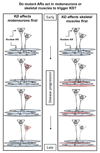Spinal and bulbar muscular atrophy: a motoneuron or muscle disease?
- PMID: 18775514
- PMCID: PMC2603477
- DOI: 10.1016/j.coph.2008.08.006
Spinal and bulbar muscular atrophy: a motoneuron or muscle disease?
Abstract
Kennedy disease (KD, or spinal and bulbar muscular atrophy) is caused by a CAG/polyglutamine expansion in the androgen receptor (AR) gene. Both motoneurons and muscles are affected by KD, but where mutant ARs act to initiate this disease is not clear. We discuss recent insights into this disease with two main themes. (1) KD is androgen-dependent, suggesting that blocking androgen action may be an effective treatment. (2) Androgens may trigger KD by acting in muscles, which indirectly affects the motoneurons, suggesting that blocking AR function in muscles may rescue motoneurons from disease and provide an effective treatment. Future research will provide a better understanding of how androgens trigger KD and the relative contributions of motoneurons versus muscles in this disease.
Figures

References
-
- La Spada AR, Wilson EM, Lubahn DB, Harding AE, Fischbeck KH. Androgen receptor gene mutations in X-linked spinal and bulbar muscular atrophy. Nature. 1991;352:77–79. - PubMed
-
- Orr HT, Zoghbi HY. Trinucleotide Repeat Disorders. Annu Rev Neurosci. 2007 - PubMed
-
- Kennedy WR, Alter M, Sung JH. Progressive proximal spinal and bulbar muscular atrophy of late onset. A sex-linked recessive trait. Neurology. 1968;18:671–680. - PubMed
-
- La Spada AR, Roling DB, Harding AE, Warner CL, Spiegel R, Hausmanowa-Petrusewicz I, Yee WC, Fischbeck KH. Meiotic stability and genotype-phenotype correlation of the trinucleotide repeat in X-linked spinal and bulbar muscular atrophy. Nat Genet. 1992;2:301–304. - PubMed
-
- Mariotti C, Castellotti B, Pareyson D, Testa D, Eoli M, Antozzi C, Silani V, Marconi R, Tezzon F, Siciliano G, et al. Phenotypic manifestations associated with CAG-repeat expansion in the androgen receptor gene in male patients and heterozygous females: a clinical and molecular study of 30 families. Neuromuscul Disord. 2000;10:391–397. - PubMed
Publication types
MeSH terms
Substances
Grants and funding
LinkOut - more resources
Full Text Sources
Medical
Research Materials

